 Most of us never knew a world without Disney animated feature films. Walt unleashed the very first one in 1937 with Snow White and the Seven Dwarfs, and this started a genre previously unknown. Since not too many of us were around in 1937, this means very few folks remember a cinematic landscape without such films.
Most of us never knew a world without Disney animated feature films. Walt unleashed the very first one in 1937 with Snow White and the Seven Dwarfs, and this started a genre previously unknown. Since not too many of us were around in 1937, this means very few folks remember a cinematic landscape without such films.
As such, it feels very difficult to comprehend what a gamble Snow White was. Mockingly referred to as “Disney’s folly”, this expensive project was commonly seen as the probable downfall of the Walt’s studio. The standard viewpoint thought that while people would enjoy cartoons for seven or so minutes at a time, there was no way anyone could sit still for a feature-length program.
Disney upped the ante further with the nature of Snow White. Rather than just create a series of nonstop laughs, this flick went with a more subtle approach and actually tried to offer a warm, emotional experience. 64 years after the fact, this seems like no big deal. We’re used to animated films that run the gamut of attitudes, and it doesn’t appear odd to feel moved by a cartoon.
Back then, however, the concept sounded absolutely ludicrous. Would people be willing to suspend disbelief for the whole 84 minutes and actually care about drawings projected at 24 frames a second? It didn’t seem possible, much less probable.
But Disney proved all of the nay-sayers wrong. Not only did Snow White fail to kill the studio, but also it provided an astonishingly rich and compelling experience that cleaned up at the box office. Single-handedly, Snow White created an entirely new artform that only grows in importance and stature with every passing year.
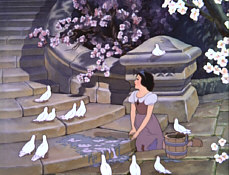 In Snow White, we find a very simple story. The existence of a princess named Snow White (voiced by Adriana Caselotti) threatens the vanity of her stepmother the Queen (Lucille LaVerne); according to the Spirit of the Magic Mirror (Moroni Olsen), Snow’s more beautiful, and Queenie can’t stand to have any competition in this area. As such, she sends a huntsman (Stuart Buchanan) to kill Snow. However, he can’t bring himself to slay her, so fakes it and simply warns her to go into hiding.
In Snow White, we find a very simple story. The existence of a princess named Snow White (voiced by Adriana Caselotti) threatens the vanity of her stepmother the Queen (Lucille LaVerne); according to the Spirit of the Magic Mirror (Moroni Olsen), Snow’s more beautiful, and Queenie can’t stand to have any competition in this area. As such, she sends a huntsman (Stuart Buchanan) to kill Snow. However, he can’t bring himself to slay her, so fakes it and simply warns her to go into hiding.
While lost in a spooky forest, Snow eventually happens upon a quaint little cottage which she soon learns is occupied by seven tiny dudes, the titular dwarfs. They quickly grow to love her as they all become one happy family. Unfortunately, the Queen learns that Snow’s still among the living, so she sets out to finish the job herself. She transforms herself into an old witch and tempts Snow with a poisoned apple. This appears to kill Snow, but by the end, a kiss from Prince Charming (Harry Stockwell) revives her, and the two live happily ever after. The queen gets hers as well.
Yes, it’s a threadbare story, but Disney makes it work nonetheless. For one, the pacing keeps the plot moving at a good rate. There are some character moments that leave the overall story for a while - most of which involve interactions between Snow and the dwarfs - but these serve the development of the participants, so they don’t seem extraneous. Although the different roles are left somewhat thin, they nonetheless seem pretty well developed considering how many of them there are and the length of the movie. Including Snow, the Queen/Witch, and the dwarfs, the movie offers nine important parts, and we also have the Huntsman and the Prince to consider. Of that bunch, only the latter really falls flat. Snow and the Queen lack depth, as they’re one-note characters, but they still feel reasonably clear and vivid.
The dwarfs are really the best of the bunch, though. The amount of personality packed into each of the seven seems stunning given their lack of individual screentime. Nonetheless, we quickly get a good feel for them, and they show nuance and character that exceed what they should have been. Granted, not all of the dwarfs are created equally, as some of them receive more face time than others; Dopey, Grumpy and Doc definitely stand out as the most prominent members of the group. However, the other four still earn our affection and interest, as they also provide clear and reasonably rich characters. (For the record, yes, I do most strongly identify with bitter misogynist Grumpy.)
 The ability to transform minor characters into fairly full-blooded and compelling characters has always been a Disney hallmark, and that trait seems at its best during Snow White. In addition to the dwarfs, the various woodland animals show lots of personality, and many of them make a strong impression despite no lines and little screentime. Creations such as these add breadth and dimension to the film and make it all the more winning.
The ability to transform minor characters into fairly full-blooded and compelling characters has always been a Disney hallmark, and that trait seems at its best during Snow White. In addition to the dwarfs, the various woodland animals show lots of personality, and many of them make a strong impression despite no lines and little screentime. Creations such as these add breadth and dimension to the film and make it all the more winning.
Although Snow herself’s somewhat bland, the horrific presence of the Queen helps spice up matters considerably. I’ve seen Snow White a few times, but I always forget just how truly nasty this character is. The Queen may well be the most evil personality in the Disney canon. She wants to kill Snow just because some dope in a mirror thinks she’s prettier, and she’ll crush anyone who stands in her way! The scene in which she transforms into the Witch shows just how wacko she is; it offers a wonderfully scary moment that helps make the Queen one of the all-time great movie villains.
For the most part, the animation of Snow White seems very good. The use of realistic human characters caused the studio serious problems, and these concerns appear from time to time. Some of the movement by these participants seems a bit stiff and awkward on occasion. For example, when Snow falls into bed at the dwarfs’ house, she does so in a jerky manner. Prince Charming gave the animators such fits that his part was cut back considerably from what it was meant to be, and he still appears light and insubstantial.
However, most of the animation works very well, especially in regard to the dwarfs. Though humans, they were treated in a more cartoony manner than the taller people, and this allows them to move in a more convincing way; the animators clearly felt more comfortable in this realm at that time, and the added confidence comes through strongly. The animals also show greater fluidity.
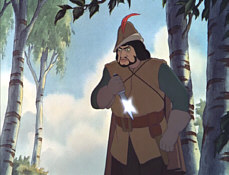 Despite some minor animation flaws, the artwork found in Snow White consistently looks excellent. The depth and intricacy of the material - especially the gorgeous backgrounds - really seems astonishing, as the work is almost always detailed and vivid. The attention to small factors really helps bring the environment to life and makes Snow White a more engrossing affair.
Despite some minor animation flaws, the artwork found in Snow White consistently looks excellent. The depth and intricacy of the material - especially the gorgeous backgrounds - really seems astonishing, as the work is almost always detailed and vivid. The attention to small factors really helps bring the environment to life and makes Snow White a more engrossing affair.
Faults? Prince Charming is one of the weakest characters to be found anywhere in Disney lore. Granted, a lot of Disney heroes are flat ciphers, but the Prince seems like one of the least compelling. He exhibits virtually no presence whatsoever and is a boring dud. Basically he and Snow connect just because the story tells them to do so; there’s no obvious reason for their romance.
Aesthetically, I never thought Snow made for much of a babe. The Queen’s definitely sexier, as Snow’s too flat and bland for my liking. Of course, tastes were definitely different back in the Thirties. In any case, I think Snow is the least attractive of all the different Disney heroines, but that’s just me!
Otherwise, Snow White and the Seven Dwarfs remains a serious winner.
One of only two animated films found on the American Film Institute's list of the Top 100 movies - along with 1940's Fantasia - Snow White belongs on that chart not just because
of its historical significance. Wonderfully drawn and animated with a
series of memorable characters and charm to spare, Snow White
provides a moving and entertaining experience that hasn't diluted over the
past six decades.
The DVD:
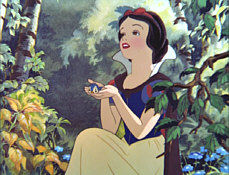 Snow White and the Seven Dwarfs appears in an aspect ratio of 1.33:1 on this single-sided, double-layered DVD; due to those dimensions, the image has not been enhanced for 16X9 televisions. Disney offered fine transfers of many older animated films; 101 Dalmatians merited a solid “A”, while Melody Time, Peter Pan and Lady and the Tramp all earned “A-“ grades. As good as those were, Snow White reached a new level for older material with a simply outstanding transfer from start to finish.
Snow White and the Seven Dwarfs appears in an aspect ratio of 1.33:1 on this single-sided, double-layered DVD; due to those dimensions, the image has not been enhanced for 16X9 televisions. Disney offered fine transfers of many older animated films; 101 Dalmatians merited a solid “A”, while Melody Time, Peter Pan and Lady and the Tramp all earned “A-“ grades. As good as those were, Snow White reached a new level for older material with a simply outstanding transfer from start to finish.
Throughout most of the film, sharpness looked excellent. The majority of the movie presented nicely crisp and detailed images. At times, the picture seemed slightly soft, but these instances were rare and the fuzziness remained minor; they didn’t detract significantly from the overall level of quality. I detected no examples of jagged edges or moiré effects, and the presentation seemed to be free from edge enhancement. Snow White also demonstrated a remarkable absence of print flaws. Virtually no defects appeared during this amazingly clean and fresh image.
Colors came across as terrifically vibrant and bold. As with many animated flicks, Snow White presented a nicely broad palette, and all of the tones looked fantastic. From the purples associated with the Queen to Snow’s blue dress to the caps and garb worn by the dwarfs, the colors remained wonderfully vivid and solid, with no signs of bleeding, noise, or other concerns. Black levels appeared to be very deep and rich, while shadow detail was appropriately heavy but never excessively thick. Admittedly, Snow White wasn’t a totally flawless picture, but it came much closer than a movie of its vintage should, so I thought it fully deserved its “A+” rating.
While the film’s Dolby Digital 5.1 soundtrack wasn’t quite as strong, it still held up nicely for its age. Of course, the audio wasn’t always a multichannel mix; the original track offered monaural sound, which also appears on the DVD. The new 5.1 version moderately opened up the soundfield but it didn’t try to reinvent the wheel. For the most part, audio stayed grounded in the center. A few ambient effects spread to the sides, but the majority of the non-central sound came from the music. The score and songs provided a gentle stereo presentation that also swelled mildly to the rears. While the audio definitely filled the forward soundstage and was reinforced by the surrounds, it didn’t show terrific delineation, so the effect seemed a little lackluster. However, I appreciated the fact the remix didn’t attempt to go nuts and create a frantic 5.1 track; the subdued approach was more appropriate, even if I wasn’t wild about the result.
 Audio quality seemed to be very good for its age. Dialogue sounded mildly thin and tinny, and I heard a little edginess along the way. However, most speech appeared quite distinct and clear, and I encountered no problems related to intelligibility. Effects were also a bit flat but they sounded pretty bright and accurate considering their vintage. The same went for the music. Songs and the score favored the higher registers, but they remained consistently crisp and relatively vivid, and they even added some fairly decent bass along the way. The soundtrack was wonderfully free of the background noise that I expect from Thirties mixes; it seemed clean at almost all times.
Audio quality seemed to be very good for its age. Dialogue sounded mildly thin and tinny, and I heard a little edginess along the way. However, most speech appeared quite distinct and clear, and I encountered no problems related to intelligibility. Effects were also a bit flat but they sounded pretty bright and accurate considering their vintage. The same went for the music. Songs and the score favored the higher registers, but they remained consistently crisp and relatively vivid, and they even added some fairly decent bass along the way. The soundtrack was wonderfully free of the background noise that I expect from Thirties mixes; it seemed clean at almost all times.
Although I often prefer tastefully done 5.1 remixes - of which this was one - I must admit that I favored the monaural track in this case. As my prior comments indicated, I had no complaints about 5.1 version and think it did a nice job of mildly reimaging the sound. However, I felt that the mono edition matched the movie better. No, that doesn’t mean that the 5.1 track suffered from any synch problems. It simply connotes that I found the mono mix to appear more natural in this instance. The additional spread of the 5.1 version appeared somewhat unnatural, as the extra breadth served to remind me that this was an old recording.
On the other hand, the mono mix felt right to me. Unfortunately, it didn’t seem quite as clean as the 5.1 track; I detected a smidgen of noise on a couple of occasions. It also lacked the same level of depth, though I found the bass response to still appear quite good for the era. While I preferred the mono track, in the end this was a “win-win” situation. Those who want the extra breadth will find a good 5.1 mix, while those who favor the original mono audio can listen to it. I’m sticking with the mono, but that shouldn’t be interpreted as a criticism of the nice 5.1 track.
As the first entry in Disney’s “Platinum Collection” of DVD releases, Snow White and the Seven Dwarfs merits extra scrutiny in regard to its supplements. Happily, the disc includes a wealth of materials spread across its two discs. On most two-DVD sets, we find almost everything on the second platter, but that’s not the case for Snow White; while DVD Two tosses in the majority of the materials, the first disc provides some substantial entries as well.
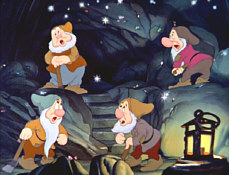 First up we find an audio commentary. After a quick introduction from Walt Disney Company Vice Chairman Roy E. Disney, we get a piece that combines new remarks from animation historian John Canemaker and archival recordings of Walt Disney. These occasionally discuss the action onscreen, but for the most part, they remain more general and don’t attempt to provide a “scene-specific” track.
First up we find an audio commentary. After a quick introduction from Walt Disney Company Vice Chairman Roy E. Disney, we get a piece that combines new remarks from animation historian John Canemaker and archival recordings of Walt Disney. These occasionally discuss the action onscreen, but for the most part, they remain more general and don’t attempt to provide a “scene-specific” track.
A similar style of commentary appears on the Fantasia DVD. That one is quite good, and the track for Snow White also offers a lot of interesting information. Disney covers the roots of the film and talks a lot about the challenges it offered. He also gives us details about the facets of animation required for the project; these don’t always specifically connect to Snow White, but they stay on the correct turf. He even reveals the resentment he once felt toward the film.
As for Canemaker, he goes over many production specifics such as the naming of the dwarfs and the problems encountered while animating the Spirit of the Magic Mirror. Canemaker helps put Disney’s statements in the correct frame of reference and makes the piece seem more coherent as a whole. Overall, the commentary offers a nice overview of Snow White and provides an entertaining and compelling experience.
Next we get a documentary called “Still the Fairest of Them All: The Making of Snow White and the Seven Dwarfs”. Hosted by Angela Lansbury, this 38-minute and 55-second program covers a mix of aspects about the creation of the film. We get a few movie clips as well as some period materials and interviews with a variety of interviews. We hear from Roy E. Disney, animation historians Canemaker, Paula Sigman, and Rudy Behlmer, past Disney employees Frank Thomas, Ollie Johnston, Jimmy MacDonald, Ward Kimball and Ken Anderson, and current Disney filmmakers Mike Gabriel, Andreas Deja, and Don Hahn.
Overall this was a somewhat superficial but generally entertaining and informative program. It provided a good overview of the subject and offered a little of everything. This meant a lack of depth, but the coverage seemed interesting and useful for the most part. It wasn’t a great documentary, but it added some fun material.
 We find one full-length short on the DVD as well. From 1934, “The Goddess of Spring” runs for eight minutes and 50 seconds and stands as an important piece historically. As discussed in some of the supplements, “Goddess” functioned as one of Disney’s first attempts to realistically animate humans; unfortunately, they weren’t terribly successful here. On its own, “Goddess” was mildly entertaining, but it’s most compelling as an indication of the progress made during Snow White.
We find one full-length short on the DVD as well. From 1934, “The Goddess of Spring” runs for eight minutes and 50 seconds and stands as an important piece historically. As discussed in some of the supplements, “Goddess” functioned as one of Disney’s first attempts to realistically animate humans; unfortunately, they weren’t terribly successful here. On its own, “Goddess” was mildly entertaining, but it’s most compelling as an indication of the progress made during Snow White.
Many Disney DVDs include Sing-Along Songs, and Snow White is no different. Here we can croon with “Heigh Ho”. The two-minute and 55-second piece shows the tune from the movie, and it can be watched with the original vocals or in a “Karaoke” version without singing. The lyrics bounce along the bottom of the screen.
“Dopey’s Wild Mine Ride” offered a game experience. You traverse through various areas in the dwarfs’ mine as you answer questions about Snow White and do a few other activities. Some of these contests stuck with random trial and error efforts that quickly became tiresome, such as “Alydar’s Adventure” on Dinosaur. Happily, the “Wild Mine Ride” was a more fulfilling affair. Some of the questions about the movie were actually fair tough, but the game was forgiving and gave you extra chances without having to start at the beginning, unlike some of the other games. Unfortunately, “Wild Mine Ride” offered no reward for successful completion, but it was a moderately fun experience.
To help ease new DVDers into the wonderful world of supplements, Snow White included two “Guided Tours”. Both hosted by Angela Lansbury, these informed us about the goodies found on both discs. The tour for DVD One offered a “sampler” of its contents and ran for 24 minutes and 25 seconds. The second tour covered DVD Two and gave us a quicker overview. It ran two minutes and 55 seconds and was much more general. In any case, DVD veterans won’t need these, but I thought they were a friendly way to introduce new folks to the format.
Because many regard Disney’s DVDs with suspicion, one extra generated a lot of controversy when initially announced. We learned that the disc would include a new recording of “Someday My Prince Will Come” by Barbra Streisand. Immediately inane rumors flew about the Internet that Streisand’s rendition would appear in the body of the film itself; instead of Caselotti, Babs would croon during the movie! While Disney’s been guilty of revisionism - DVDs like Make Mine Music, Saludos Amigos and Melody Time have all altered the original work for video release - there was no way they’d actually revoice a classic movie in this manner.
 Instead, Streisand’s performance appears as something of a music video. Even so, the presentation will inspire some complaints. Immediately following the end of the movie, we find a videotaped introduction from Disney chief Michael Eisner and then see this Streisand clip. Babs doesn’t appear in the piece; instead, her typically treacly and overdone version of the song plays over various snippets from the movie. I’m sure many will enjoy it, though I can’t imagine why.
Instead, Streisand’s performance appears as something of a music video. Even so, the presentation will inspire some complaints. Immediately following the end of the movie, we find a videotaped introduction from Disney chief Michael Eisner and then see this Streisand clip. Babs doesn’t appear in the piece; instead, her typically treacly and overdone version of the song plays over various snippets from the movie. I’m sure many will enjoy it, though I can’t imagine why.
Anyway, this clip can be accessed from the supplements menu or watched right after the end of the movie. It comes up automatically if you don’t use your remote to return to the main menu. Is this a big deal? I don’t think so. The video’s totally separate from the film itself, and it takes a single touch of a button to avoid it. However, I’ve already started to see complaints about its presence at the end of the flick. Though these recognize that the video can easily be skipped, they whine because they shouldn’t have to go to such efforts.
Such is the burden of being Disney. Anything the studio does that can be viewed negatively will inspire complaints. They get hammered for things that seem minor compared to some other studios’ activities, and this is another instance of the Disney effect. If the fact you need to press a button to avoid Babs really bothers you, I think you really should learn to relax.
I’m especially irked by the mild criticism inspired by the placement of the video because of all the nice touches on this DVD. While I enjoy creative animated menus on DVDs, I hate it when I’m forced to watch them every time I try to access a feature. For example, those found on The Phantom Menace are very cute and fun, but they quickly get old, and I loathe my inability to ever avoid them.
Happily, Snow White doesn’t suffer from that concern. The Magic Mirror pops up whenever you make a move, but you can easily bypass these animations with your remote. This makes the menus much easier and quicker to navigate, and they allow me to enjoy the work without the irritation that accompanies many other presentations. I have no clue why so many DVD producers feel compelled to force us to watch different aspects of the packages, so I love it when I receive a choice.
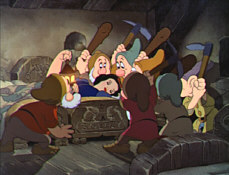 DVD One also provides some DVD-ROM materials. The “Princess Fashion Boutique Game” lets you dress up a computer-drawn girl. Somehow I don’t think I’m the target audience for this one - at least I really hope I’m not - so it’s hard to judge, but I guess young girls would dig this. Note that it exists essentially as a promotional tool for a more substantial CD-ROM program.
DVD One also provides some DVD-ROM materials. The “Princess Fashion Boutique Game” lets you dress up a computer-drawn girl. Somehow I don’t think I’m the target audience for this one - at least I really hope I’m not - so it’s hard to judge, but I guess young girls would dig this. Note that it exists essentially as a promotional tool for a more substantial CD-ROM program.
In addition we find a link to the Snow White website as well as one for “DVD Exclusive Online Content”. The latter provides computer wallpaper, translations of dwarf names into 17 languages, a “Scene Builder” that lets you create some static pictures which can then be printed and colored, and “Behind the Scenes”. The last one tosses in some “interviews from the making of the Disney timeline”. We find 113 seconds of mildly interesting remarks from Fess Parker, Angela Lansbury, and Dean Jones.
That finishes the extras found on DVD One. DVD Two introduces a slew of additional materials, all of which appear in different domains. Snow White’s Wishing Well includes a few segments. “History” breaks down into three text pieces. “Walt Disney Biographical Timeline” gives us 58 screens about Walt’s life. These go over the basic milestones through the Oscars for Snow White; we learn nothing post-1939.
In addition, “Snow White Production Timeline” discusses important dates related to the movie. These include 67 screens of text, and they progress through the 1993 re-release of the film. Lastly, “The Original Brothers Grimm Fairy Tale” shows exactly what the title describes: a text edition of the story. It’s a cool addition since it lets us see the similarities and differences between the two renditions.
The “Storyboard to Film Comparisons” start with a 20-second introduction from John Canemaker that discusses that aspect of the process. After that, you can check out four different scenes from the film: the “Forest Chase”, “Cleaning House”, “Dwarfs Chase the Witch”, and “The Queen’s Order”. Each snippet runs between 46 seconds and three minutes, 26 seconds for a total of nine minutes and 17 seconds. You can view the original storyboards, the final film, or a split screen combination of the two; you can flip through them via the “angle” button on your remote. It’s a good presentation of this material.
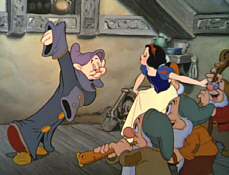 When we move to The Queen’s Castle we encounter a mix of visual materials. “Art and Design” provides a 102-second discussion of these design elements from John Canemaker; it’s obviously superficial, but it’s a nice start to the subject. “Visual Development” provides a nice collection of still galleries. Spread through three “halls”, we get 185 thumbnail images of production design materials; you can click on these to enlarge them. In addition, the DVD provides an “Audio Guided Tour”. When you see a little apple in the thumbnail, click on that item and you’ll hear a little audio information about it. The details are a little sparse, but this is still a fun and interesting addition.
When we move to The Queen’s Castle we encounter a mix of visual materials. “Art and Design” provides a 102-second discussion of these design elements from John Canemaker; it’s obviously superficial, but it’s a nice start to the subject. “Visual Development” provides a nice collection of still galleries. Spread through three “halls”, we get 185 thumbnail images of production design materials; you can click on these to enlarge them. In addition, the DVD provides an “Audio Guided Tour”. When you see a little apple in the thumbnail, click on that item and you’ll hear a little audio information about it. The details are a little sparse, but this is still a fun and interesting addition.
In “Cameras and Tests”, we get materials that deal with additional technical subjects. “Excerpt from ‘The Story of the Silly Symphony’” briefly spotlights some use of the multiplane camera. The 95-second snippet comes from an October 1957 Disneyland TV broadcast. The clip’s too short and doesn’t offer much, unfortunately, mainly due to its brevity.
Another TV piece comes in the “Excerpt from ‘Tricks of Our Trade’”. In this February 1957 show, we hear more about the multiplane, and it offers a much more satisfying demonstration of the need for the camera and its capabilities and processes. Overall, this seven-minute and 40-second bit provides a fairly satisfying look at this area.
“Camera Tests” shows a mix of work done to determine the look of various aspects of the film. Introduced and narrated by film restorer Scott MacQueen, this piece offers an interesting look at some historical material, and MacQueen’s explanations help put the shots in perspective. It’s a good 12 minute and 10 second examination of this footage.
The “Animation” area finishes The Queen’s Castle. It starts with “Voice Talent”. In this six minute and 20 second program, we hear from Roy E. Disney, film historians Paula Sigman, Rudy Behlmer, and John Canemaker and also see some archival - but fairly modern - footage of animators Frank Thomas and Ollie Johnston and actress Adriana Caselotti. Overall, we get a quick discussion of how the actors got their parts and learn a smidgen about some of their careers. It should have been more detailed, but it’s an interesting introduction nonetheless.
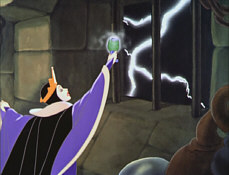 “Live Action Reference” provides some of the film footage shot to help the animators create more believable material. Narrated by Scott MacQueen, this six-minute and 45-second piece shows us a lot of great inspirational footage, and I thought it was a terrific little extra.
“Live Action Reference” provides some of the film footage shot to help the animators create more believable material. Narrated by Scott MacQueen, this six-minute and 45-second piece shows us a lot of great inspirational footage, and I thought it was a terrific little extra.
Next we get another excerpt from that February 1957 “Tricks of Our Trade” TV program. This part retains a focus on the use of live action footage to improve animated movement. The four-minute and 10-second snippet seems a bit redundant - the dancing fat-man material appears elsewhere - but it’s still interesting to see.
Finally, the “Character Design” area includes three more subsections, all of which offer art galleries. “Snow White and the Dwarfs” gives us three “halls”, each of which includes between 42 and 76 stills for a total of 185 images. “The Queen/The Peddler” includes an additional 52 pictures, while “The Huntsman/The Prince/The Animals” tosses in another 42. There’s some fine stuff to be found here, from early sketches to more refined pieces. As with other galleries on this DVD, you have the option to use the “audio guided tour”; this provides brief comments for 14 “Snow/Dwarfs” drawings, nine “Queen/Peddler” images, and six “Huntsman/Prince/Animals” pieces. The material’s not tremendously detailed but it contributes some useful information and remains a welcome addition to the DVD.
Now we progress to The Queen’s Dungeon, a domain that covers two subtopics. “Abandoned Concepts” begins with an “Introduction” from Canemaker. In this 55-second snippet, he gives us a very brief overview of what we’ll soon see. As such, it feels a little redundant, though Canemaker adds a little helpful perspective.
Next we get glimpses of the unutilized ideas themselves. Note that these differ from some “Deleted Scenes” yet to come. The latter were more fully prepared for use in the film, while the “Abandoned Concepts” died long before any animation occurred. We find three scenes: “Snow White Meets the Prince”, “’Some Day My Prince Will Come’ Fantasy Version”, and “The Prince Is Captured”. These are presented as animatics: filmed storyboards accompanied by the appropriate production audio. Each clip runs between 87 seconds and four minutes, 23 seconds for a total of eight minutes and three seconds of material. All three were interesting, though “The Prince Is Captured” seemed most valuable; the first two were variations of already-included scenes, but “Captured” offered something totally new.
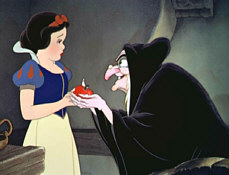 “The Restoration” gives us a quick look at the work done for this glorious new presentation. During the five minute and 15 second piece, we hear from Chris Carey (Senior Vice President, DVD Production), Jeff Miller (Senior Vice President, Character Voices and International Dubbing Production) and Terry Porter (Executive Director, Sound Department) as they discuss the challenges presented and the attempts made. Although not really necessary to appreciate the transfer, it should help show just how much had to be done for it.
“The Restoration” gives us a quick look at the work done for this glorious new presentation. During the five minute and 15 second piece, we hear from Chris Carey (Senior Vice President, DVD Production), Jeff Miller (Senior Vice President, Character Voices and International Dubbing Production) and Terry Porter (Executive Director, Sound Department) as they discuss the challenges presented and the attempts made. Although not really necessary to appreciate the transfer, it should help show just how much had to be done for it.
In The Dwarfs’ Mine, we discover three subdomains. “Deleted Scenes” begins with an “Introduction” from John Canemaker. Another short overview, the 38-second piece minimally sets up what we’ll soon see.
From there we find five different deleted scenes: “The Witch at the Cauldron”, “The Bedroom Argument”, “’Music In Your Soup’”, “The Lodge Meeting”, and “Building a Bed”. These run from 38 seconds to four minutes, 52 seconds for a total of 13 minutes and 47 seconds of material. Only the “Witch” clip features fully finished and painted animation; the others mostly provide rough pencil work, and a few - particularly “Building” - depend on some storyboards as well. For the most part, we hear the original production audio, though it seems clear that some of the dialogue was revoiced more recently.
No matter - this stuff is still gold. In general, deleted material is rare for animation. Due to the expense of creating shots, the process heavily uses storyboarding to work out the pacing before any animation starts. However, since Snow White was a brand-new form of film, obviously Walt and company had some lessons to learn, so we find much more unused animation than usual. I don’t think any of the clips should have remained in the movie but they’re a treat to see.
In a 93-second piece, we see the “Original RKO Opening and End Credits”. As discussed by Scott MacQueen in his narration for this clip, RKO originally distributed Snow White, but a couple of decades later, Disney did so itself and altered the credits to remove the RKO references. These restore the original appearance, though they aren’t actually the original materials; according to MacQueen, those are lost, so this bit recreates them.
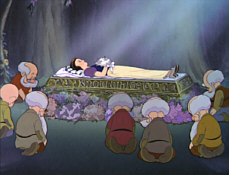 “Disney Through the Decades” provides a 41-minute romp through the history of the studio. After a brief look at the first few decades of the 20th century, the program begins in earnest with the Thirties and continues with segments continue through the start of the 21st century. Each decade has a different host; we hear from D.B. Sweeney, Roy E. Disney, Angela Lansbury, Fess Parker, Robby Benson, Dean Jones, Jodi Benson, and Ming-Na. Anyone who expects a solid account of the studio’s past will walk away disappointed, as this excessively promotional and laudatory piece contributes nothing other than accolades. It contains some decent material, but the superficial nature of the piece makes it somewhat grating.
“Disney Through the Decades” provides a 41-minute romp through the history of the studio. After a brief look at the first few decades of the 20th century, the program begins in earnest with the Thirties and continues with segments continue through the start of the 21st century. Each decade has a different host; we hear from D.B. Sweeney, Roy E. Disney, Angela Lansbury, Fess Parker, Robby Benson, Dean Jones, Jodi Benson, and Ming-Na. Anyone who expects a solid account of the studio’s past will walk away disappointed, as this excessively promotional and laudatory piece contributes nothing other than accolades. It contains some decent material, but the superficial nature of the piece makes it somewhat grating.
Our final stop on DVD Two, The Dwarfs’ Cottage covers some material that followed the completion of Snow White. “The Premiere” provides two subtopics. “The Los Angeles Premiere” features a newsreel that discusses the event in a fun 72-second snippet. The “Original Premiere Radio Broadcast” goes into much more detail. A half an hour long, this program features introductions of many of the stars who attended the premiere. These are intermixed with audio excerpts from the movie to create a generally promotional but interesting piece.
In the “Trailers” department, we find eight ads for Snow White. Two are from 1937, while one each come from 1944, 1958, 1967, 1987, 1993, and 2001. These are great fun to see, especially as a way to compare marketing techniques over the years. Note that the same clips appear during “Disney Through the Decades”.
“Publicity” gives us three more subdomains. The “Scrapbook” breaks down further into another five areas: “The Premiere”, “Pressbook”, “Production Photos”, “Merchandise”, and “Posters”. Using the same thumbnail format featured in other still galleries, we can access 60 images in all; each section includes between five and 17 frames. There’s some great stuff here, though the total number of pictures seems a little low; clearly a lot more of them exist.
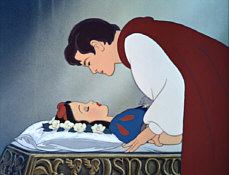 “A Trip Through Walt Disney Studios” lasts nearly 11 minutes as we get a look at the process behind the making of animated films. After an introduction from Scott MacQueen, we see a surprisingly tight and informative discussion of the various stages; it went over the process with solid depth and detail for its length. “How Disney Cartoons Are Made” runs for eight minutes and 55 seconds and essentially exists as an alternate version of “Trip”. The former was created for exhibitors, while the latter was fashioned for audiences prior to the general February 1938 theatrical run of Snow White, and some touches showed the difference. “Made” added some more promotional notes and seemed less focused. A few small alterations meant it was worth a look, but if you’ve watched “Trip”, you’ve pretty much seen “Made” as well.
“A Trip Through Walt Disney Studios” lasts nearly 11 minutes as we get a look at the process behind the making of animated films. After an introduction from Scott MacQueen, we see a surprisingly tight and informative discussion of the various stages; it went over the process with solid depth and detail for its length. “How Disney Cartoons Are Made” runs for eight minutes and 55 seconds and essentially exists as an alternate version of “Trip”. The former was created for exhibitors, while the latter was fashioned for audiences prior to the general February 1938 theatrical run of Snow White, and some touches showed the difference. “Made” added some more promotional notes and seemed less focused. A few small alterations meant it was worth a look, but if you’ve watched “Trip”, you’ve pretty much seen “Made” as well.
Finally, the “Vintage Audio” section completes DVD Two. “Radio Broadcasts” include three programs. There’s one “Lux Radio Theater” snippet from September 28, 1936 that runs three minutes, 52 seconds, and another from December 20, 1937; it goes for four minutes and 16 seconds. The former features Walt as he chats with Cecil B. DeMille as they discuss Mickey Mouse and the then-ongoing progress of making Snow White. Cecil B. also yaks it up with Mickey himself. The 1937 piece again features DeMille as he talks with Walt immediately prior to the premiere of Snow White. They talk about some aspects of the film and Walt’s future plans. Both clips are interesting historical curiosities.
A more substantial program, the “Mickey Mouse Theater of the Air” touts Snow White in a January 9, 1938 broadcast. We hear from Walt Disney, many of the Snow White personalities, and other characters like Mickey Mouse and Donald Duck. The 28-minute and 34-second show is just a piece of entertainment that serves to promote the flick, but it’s a fun diversion. One curiosity: I couldn’t tell if the various Snow White voices were all the original film actors or not; Snow herself sounded especially different from the movie, so I’d be interested to find out if all of them appeared on the show.
“Radio Commercials” tosses in seven ads; three are from 1958, while the other four come from 1967. Those from the Fifties are the most entertaining, if just because they feature Disney stalwart Hans Conried.
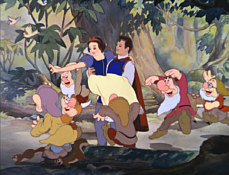 “Songs” gives us an excerpt from the recording session of “Silly Song”. It lasts three minutes and 13 seconds. We also find a deleted song, “You’re Never Too Old to Be Young”, which runs for three minutes and 17 seconds. “Silly Song” starts with an introduction from Disney audio technician Terry Porter, who tells us the background of the piece. We don’t hear the entire “Song” itself; instead, the clip includes different takes of parts of it, and it’s very entertaining. The second simply offers the unused tune in its entirety.
“Songs” gives us an excerpt from the recording session of “Silly Song”. It lasts three minutes and 13 seconds. We also find a deleted song, “You’re Never Too Old to Be Young”, which runs for three minutes and 17 seconds. “Silly Song” starts with an introduction from Disney audio technician Terry Porter, who tells us the background of the piece. We don’t hear the entire “Song” itself; instead, the clip includes different takes of parts of it, and it’s very entertaining. The second simply offers the unused tune in its entirety.
Inside the DVD case we find a fairly solid booklet. This includes a nice introduction from Roy E. Disney plus a detailed look through the package’s contents. It all helps make this a rich and user-friendly experience for both new DVD fans and old hands.
Snow White and the Seven Dwarfs began Disney’s wonderful legacy of animated features, and it did so in fine style. The movie deserves attention for reasons above and beyond its seminal status, as it provides an entertaining and warm experience accompanied by excellent animation and artwork. The DVD provides absolutely excellent picture quality as well as very solid sound for its era and a collection of many terrific supplements. Snow White and the Seven Dwarfs is a verified classic that belongs in the collection of every animation fan.